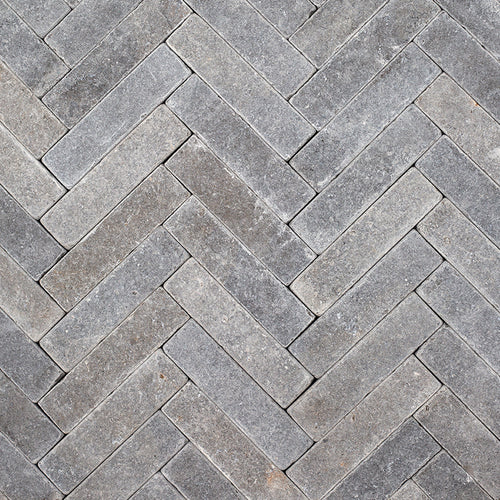Herringbone Brick Paving Ideas
Herringbone paving, also known as herringbone pattern or herringbone brickwork, is a classic and timeless method of arranging rectangular bricks to create a distinctive and visually appealing look. This pattern has a rich history that dates back to ancient civilisations and has been utilised in various forms across different time periods. From ancient Roman roads to Elizabethan Renaissance designs, herringbone pavers were often put in combination with other patterns to create intricate and artistic designs on floors and walkways. Now, herringbone brick paving is widely used in homes and gardens as a perfect addition to outdoor spaces and patios.

Limestone brick pavers offer a dense and hardwearing material, providing both charm and practicality for all sized spaces, from a small cottage courtyard to large country gardens alike. Limestone bricks or stackers are not limited to the herringbone pattern, there are many ways to lay these outdoor tiles and this post will cover the most popular laying formats. These stone stackers can be complemented with our matching large format stone paving, offering cohesion between your hardscaping and planting.
1. Vertical Herringbone Paving
Starting with a favourite, herringbone tiles have always been a wonderful laying pattern to enhance any tile and they seem to be having their moment with a resurgence of the herringbone tile look. The most familiar example of achieving this format is with a vertical herringbone whereby the tiles are angled at 45 degrees, creating a linear pattern that works particularly well for pathways to patios.
2. Horizontal Herringbone Paving
Similarly to vertical herringbone paving, horizontal herringbone follows the same way of the tiles being installed at 45 degrees but creating a horizontal pattern. Although it is simply rotating the direction of the herringbone, this is highly effective to give a different look with the stone stackers and can help widen the appearance of narrow patios or garden paths.
3. Diagonal Herringbone Paving
The alternative herringbone paving pattern option is to install the bricks diagonally. Although less common, a diagonal herringbone can really add interest to a garden scheme and offers a modern take on a traditional design. Instead of a linear design, this creates more of a staggered step effect with every brick sitting horizontally or vertically next to each other.
4. Horizontal Staggered Brick Paving
Quite possibly the most classic way to lay tiles, a horizontal brick bond, also known as a running bond or stretcher bond, is a common pattern used in tiling whereby the stone stackers are staggered by a half in length - a timeless laying format.
5. Horizontal Stacked Brick Paving
Another classic, but with clean lines, a horizontal stacked bond is where each tile sits directly on top of another with no staggering of the grout joints. Horizontal stacked brick limestone paving is especially impactful in contemporary garden schemes.

6. Vertical Staggered Brick Paving
As the name suggests, this is the same ½ brick bond but flipped vertically which can give a very different look and feel to the limestone bricks and help elongate spaces. Laying the stackers vertically can instantly create a more contemporary style and is effective for pathways and entryways between patios and other parts of the garden.
7. Vertical Stacked Brick Paving
A popular way to lay brick paving tiles currently is using a vertical stacked bond. This laying format achieves clean grout lines and a neat look for garden paths and paving, also working in more contemporary style outdoor areas.

8. Double Weave or Basketweave Brick Paving
The double weave pattern is an outdoor laying trend we love for its ability to add a creative and decorative feel to the simplest of spaces. Inspired by basket weave tiles, the collection of limestone brick paving work perfectly with this format whereby the width is a ¼ of the length, meaning the tiles can be laid vertically and then horizontally in sets of four.

















